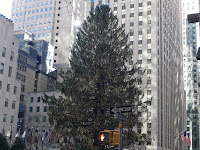I was in Manhattan on Sunday. I would have otherwise been in
front of my television set watching the Sunday morning news programs, which was
something I desired avoiding at all costs. I just said no to the sights and
sounds of alternative fact-spouting flacks and yes to the great
outdoors.
Due to construction, the Number 1 train was running from
W242nd Street in the Bronx to 14th Street, instead of South Ferry, in
Manhattan. Since I typically exit on 14th Street on these spontaneous
adventures of mine, all was well. The fact that the Number 1 was operating a
shorter run than the norm, and bypassing several stops, made it “Special”
apparently. Yes, that special word replaced “South Ferry” as the train’s
last stop on the individual subway car signs. The best laid plans of mice and
men: This special train trip didn’t quite make it to 14th Street. At 137th
Street, we passengers were held in the station for a few minutes, awaiting
clearance from a dispatcher that never came. The conductor at last broke the
bad news. “This train is going out of service!” he announced. Translation:
Everybody out!
I patiently waited with everyone else for the next Number 1
to come along but—despite it, too, being special—the train was not
surprisingly overcrowded. As a C-Leg wearer, I abhor crowds. (I didn’t
particularly like them pre-C-Leg.) But I wasn’t in a particular hurry, so I
decided to wait the eight or so minutes for the next train. At the far end of
an elongated underground subway station, I stood alone with the sole exception of an
unhinged-looking fellow ambling my way. I took this reality snapshot as the
latest sign that I should navigate my way onto street level and commence my
Manhattan journey from there. (I employed a variation of my Charles Manson Rule
for subway travel. And because of it, found myself at an unusual starting
point—way, way up north and walking southbound, the direction the special
Number 1 train was supposed to take me.)
So, on this sunny, benign winter’s morning, I strolled down
Broadway in the environs of City College and then Columbia University. I hoped prayed
that I wouldn’t be subject to any “Crazy Creamsicle” Trump chatter or protests,
because I wanted a few hours free of presidential thoughts and, again, I don’t
like crowds. Despite the bizarre antics of the aforementioned
commander-in-chief in his first ten days in office, life in the big city went
on without a hitch. I didn’t overhear or detect any political babble
at all. I passed by Tom’s Restaurant of Seinfeld fame and felt compelled
to take the obligatory picture. I should eat in there one of those days, I
thought, before it, too, is claimed by New York City’s diner purge.
I had actually forgotten as I wandered through this area of Manhattan
that it had a few hills to navigate, which like crowds, I’d prefer not tackling
on a C-Leg. Fortunately, I passed through unharmed. At one point, I found
myself at the intersection of hoity-toity West End Avenue and 100th Street,
where I spied a telephone booth. Pay phones are getting increasingly hard to
find nowadays, but I thought phone booths had gone the way of the Rolodex.
Perhaps Clark Kent lives in the area.
I was back on Broadway at 96th Street, a slice of earth I
hadn’t traversed above ground in fifteen years, I'd guess. There was a diner called
Happy Burger in the vicinity, I recalled, which I patronized once upon a time.
I wondered if it was still there, but suspected it was more than likely a
casualty of gentrification. The surrounding area told me in no uncertain terms
that Happy Burger’s ship had sailed. A CVS drug store covered a good portion of
the block where Happy Burger once served coffee at a tiny fraction of the new
king of the hill: Starbucks.
Upon my return home, a Google search filled me in on all I
needed to know about the demise of Happy Burger. It had closed its doors in
2004, I learned. Its Greek immigrant owners had planned to keep the place open
until their lease expired in 2008, but the landlord made them an offer they
couldn’t refuse to close shop four years earlier. They shut Happy Burger down
without giving their many loyal patrons a right and proper heads-up. Life...life. A unexpected special train going out of service and a deranged-looking man on a
subway platform augured the unhappy discovery that Happy Burger—like so many
happy things—is no more.
(Photos from the personal collection of Nicholas Nigro)

















